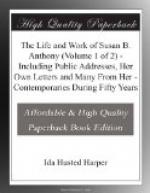She returned home, and on March 4 cast her ballot at the city election without any protest. Only two other ladies could be induced to vote, Mrs. Mary Pulver and Mrs. Mary S. Hebard. All of the others who had voted in the fall were thoroughly frightened, and their husbands and other male relatives were even more panic-stricken.
In the midst of her own perplexities Miss Anthony did not forget to issue the call[69] for the May Anniversary in New York, where she made an address, detailing the incidents of her arrest and defending her rights as a citizen. All the speeches and letters of the convention were deeply sympathetic, and among the resolutions bearing on this question was one stating that since the underlying principle of our government is equality of political rights, therefore “the trial of Susan B. Anthony, though ostensibly involving only the political status of woman, in reality questions the right of every man to share in the government; that it is not Susan B. Anthony or the women of the republic who alone are on trial today, but it is the government of the United States, and that as the decision is rendered for or against the political rights of citizenship, so will the men of America find themselves free or enslaved.”
A reception was given by Dr. Clemence Lozier, founder of the Woman’s Homeopathic College of New York, who was always Miss Anthony’s faithful and devoted friend, never shaken in her trust by any storm that raged. During the darkest days of her paper, The Revolution, when the generosity of all others had been exhausted, Dr. Lozier gave her $50 every Saturday for many weeks and helped her by so much to bear the weight of the financial burden. For more than a quarter of a century her hospitable doors were always ajar for her, and it was to be expected that, at this crucial moment, she would again express her loyalty.
Miss Anthony’s trial was set for the term of court beginning May 13, and she decided to make a canvass of Monroe county, not to argue her own case but in order that the people might be educated upon the constitutional points involved. Commencing March 11, she spoke in twenty-nine of the post-office districts. Being informed that District-Attorney Crowley threatened to move her trial into another county because she would prejudice the jury, she notified him she would see that that county also was thoroughly canvassed, and asked him if she were prejudicing a jury by reading and explaining the Constitution of the United States.




